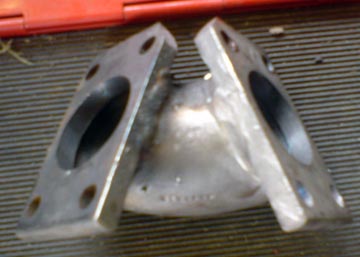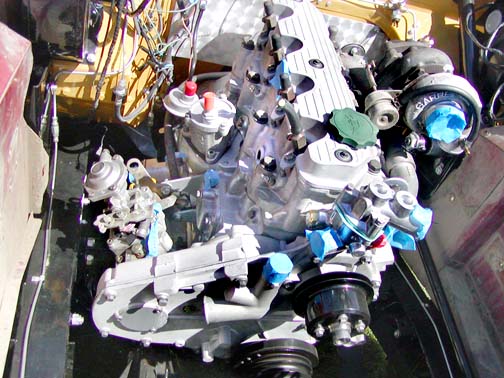
|
Converting a Series Land Rover to a 200 tdi engineMuch of the information from this conversion comes
from Glen Anderson and other members of the series II club.
|
Gear |
1 |
2 |
3 |
4 |
5 |
|---|---|---|---|---|---|
Series C suffix & newer |
3.60:1 |
2.22:1 |
1.50:1 |
1:1 |
- |
LT77/LT77S, 200 tdi |
3.59:1 |
2.30:1 |
1.507:1 |
1:1 |
0.83:1 |
Below is a comparison of gear ratios for a 200tdi Defender with common Series configurations
|
Low range |
High range |
Ashcroft high range |
Roverdrive 4th gear |
LT77 5th gear |
Series transfercase gear ratio |
2.35:1 |
1.15:1 |
0.87:1 |
|
|
Series overall ratio at wheel, 4th gear |
11.10:1 |
5.4:1 |
4.09:1 |
4.3:1 |
|
200tdi transfercase gear ratio |
3.32:1 |
1.67:1 |
|
|
4.54:1 |
200tdi overall ratio at wheel, 4th gear |
11.75:1 |
5.9:1 |
|
|
4.14:1 |
Series gearboxes are stronger and under less stress when in fourth gear, so fourth and fourth overdrive are the gearbox's strongest gears. The D suffix and newer Series gearboxes have stronger shafts than C suffix and lower gearboxes (no clip groves) and the Roverdrive is the strongest of the overdrives made to fit a Series transfercase. The LT77S is a stronger 5 speed than the LT77 and the series gearboxes. The LT77's bell housing is longer than the Series bell housing and the gearbox is longer making it a poor fit into an 88 (very short rear propshaft). Also don't forget that the LT77's and LT230 ratios that were supplied with North American spec V8 Defenders and Discoverys are quite different and taller than the ratios the 200tdi seem to prefer.
Clutch:
The Land Rover 2.5L diesel 9.5” clutch pressure plate (part # 571228) and friction plate (part # FRC2297) will bolt straight on to the 200TDI flywheel and mate with the series II/IIA gearbox.
Steering box clearance:
The stock LHD steering box location is a problem. The turbo is very close with a Defender intake manifold and it is in the way with a Discovery intake manifold. The conversion to a 200tdi would be an excellent time to convert a Series Land Rover to power steering.
Front differential clearance:
The front differential can come in contact to the 200 tdi crank pulley during off road situations where the axle is pushed up to the bump stops. Military bump stop extensions should prevent this from ever happening. Tired flat springs exacerbate the problem so make sure you have good springs up front with proper arch. If you have an 88 consider using standard 109 spring shackles (not military). Standard 109 spring shackles are about a half inch longer than standard 88 spring shackles.
Discovery exhaust manifold and the frame:
The Discovery 200tdi intake manifold sits down low on the left side of the engine intefering with a LHD steering box and possibly the frame rail. A 109 frame is an inch taller than an 88 frame in this position. The turbo sits hard against the 109 frame before the engine mounts are seated. A Discovery turbo might fit a LHD 88 with power steering by shimming the engine mounts a ltttle. Steve Parker Land Rover Ltd has a front exhaust pipe with tight bends designed to be used when a Discovery 200tdi is being installed into a Defender. This special tube along with the conversion to power steering might allow the more common (and likely cheaper) Discovery 200 tdi to be used in an 88. |
Discovery manifolds will NOT fit into a 109 |
 |
Where there is will, and a bit of clever thought, there is a way. "Grandap Safari" had a custom adaptor welded up to go between a 200tdi Discovery exhaust manifold and the turbo that bends the turbo up from the frame. On the other hand, what is to prevent a company that specializes in making custom exhaust headers from making a steel tube exhaust header that optimiizes the loccation of the turbo in a Series engine bay? |
Non turbocharged 200Di conversion
Richard at Glencoyne Enginnering makes a good case for installing a 200tdi engine without the turbo. A good engine with burned out turbo out of a Discovery is much cheaper. The engine is under less streass so will last loger. It gets even better fuel milage than the turbo version and without a turbo. A 200Di has about 75-80 hp, slightly more than a healthy 2.25L petrol engine, only with a lot more bottom end torque. Richard's test 88 conversion gets 35 UK MPG ( 29 USMPG) on the open highway.
Read Richard's step by step instructions covering his 200Di conversion into a Series Land Rover
Exhaust system by Mark Rumsey
Turbo engines do not like backpressue at all. Not only does it sap power in the usual way restrictive exhausts do, it also causes the turbo to come on boost later and deliver lower boost pressures. I think you will find the TDi will perform pretty poorly and be comparatively thirsty if you try and run it through a standard exhaust. Even when you're not using the full output, if the turbo is producing boost the engine could be shifting about half as much exhaust gas again as a normally aspirated engine (at full boost it could be shifting twice what an N/A engine produces) and will feel seriously bunged up. There is also the potential problem of higher exhaust port and valve temperatures as the engine is having to work harder to get rid of the gas and the gas will be hanging around inside the engine longer. If you can't afford a full system at the moment I would suggest as a minimum getting hold of a TDi, V8 or even a 6 cylinder silencer from somewhere and work that in somewhere in place of the standard silencer even if you can't go as far as fitting the larger diameter pipe.
Cooling:
I've been told that a Series thermostat housing can be used on a 200tdi engine allowing a heavy duty Series radiator to be used along with an intercooler and an oil cooler. Either way, the 200tdi is easily damaged through overheating and care should be taken when designing a cooling system for the engine. Because of this you need to monitor the engine temperature. It you want to reuse your old electric temperature gauge you have two choices. One is that the green top 300tdi sending unit ( part # AMR1425) is can be used instead of the 200tdi sender, which is way off. The 300tdi sender unit is not an exact match for the gauge but it is close enough for you to get a good idea of what is going on. You other option is to cut a cooling hose and insert a metal 'T' with a pipe fitting threaded hole and use a stock Series sending unit. If you have a gauge hole free you can always buy an electric temp. gauge with a metric threaded sending unit.
A BIG concern should be parts:
Cylinder heads (LR # RTC6896)
are NLA
Defender intake
manifolds (LR # ERR1435) are NLA
Defender exhaust manifolds (LR # ERR678) are listed but dealers have not been
able to get any since fall of '06
Normal consumable part supplies are OK but no one has made any attempt to produce replacements to major components since owners would normally be expected to swap in a 300tdi engine, which is harder to fit into a Series Land Rover.
Reports from actual 200tdi into Series Land Rover conversions:
- Glen Anderson's conversion, still in process
- Mark and Forrest Clifton's conversion
- Wiring a 200tdi after transplant into a Series Land Rover
Conversion writeups on other sites:
- LR4X4 forum - Disco 200tdi into a Defender
- Muddy Tyres - Disco 200tdi into Defender
- Nicks Jungle - Defender 200tdi into a Defender
- Richard of Glencoyne Engineering has a top notch writeup about installind a 200DI (no turbo) into a Series rig.
If you would like to discuss any of the contents, or just say hi, please feel free to .
© 1997, 2001, 2017 TeriAnn Wakeman. All rights reserved.

